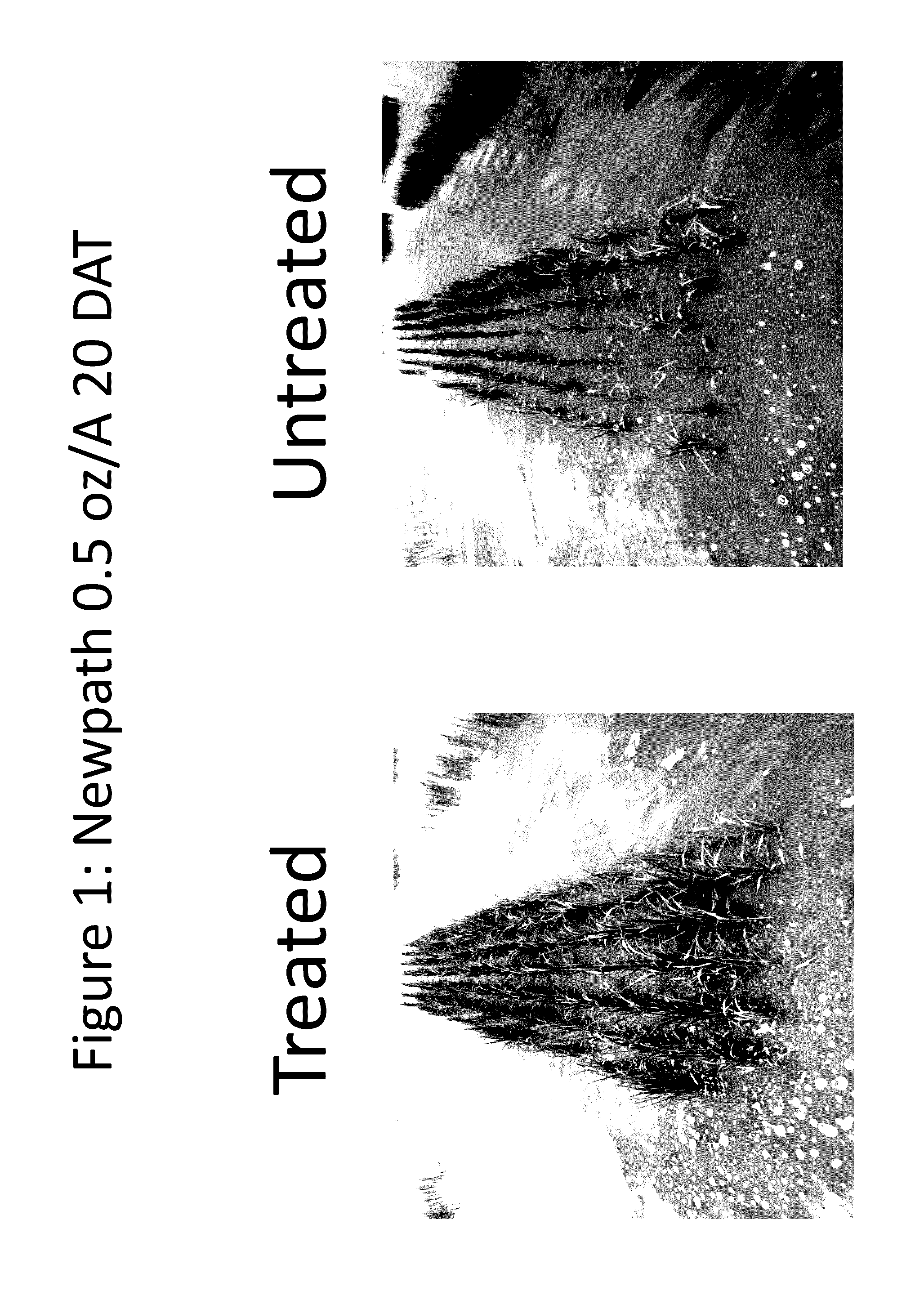Method of improving tolerance of plants to herbicides using seed insecticide treatments
a technology of herbicide treatment and tolerance, applied in the field of improving the tolerance of plants to herbicides using seed insecticide treatment, can solve the problems of reduced yield, increased risk of plant injury, and inability to tolerate clearfield hybrids, so as to increase the herbicide tolerance of hybrid or partially tolerant plants, reduce the injury of plants, and ensure rice.
- Summary
- Abstract
- Description
- Claims
- Application Information
AI Technical Summary
Benefits of technology
Problems solved by technology
Method used
Image
Examples
example 1
CruiserMaxx can Increase Tolerance of Rice to Herbicides
[0035]This experiment was conducted at a farm located just north of Lonoke, Ark. in the summers of 2013 and 2014. The soil texture is a silt loam with a pH of 6.3. Conventional rice (Roy J) was planted on Apr. 30, 2013 and May 20, 2014 with a Hege cone drill calibrated to deliver a seeding rate of 90 pounds (lbs) / Acre on 7.5-inch rows. Plot size was 5×25 feet. The study was conducted with a randomized complete block design having 4 replications.
[0036]Treatments consisted of seed treatment and herbicide combinations. The seed treatments consisted of “treated seed” on which CruiserMaxx Rice at 7 oz / 100 lb of seed was applied. CruiserMaxx Rice contains 26.4% thiamethoxam, 1.65% mefenoxam, 1.32% azoxystrobin, and 0.28% fludioxonil. The second seed treatment was considered the “nontreated seed” which actually received equivalent amounts of azoxystrobin, mefenoxam and fludioxonil as the treated seed but without the insecticide thiame...
example 2
Other Insecticides can Increase Rice Tolerance to Herbicides
[0052]This experiment was conducted at the UAPB Research Station, near Lonoke Ark. and the RREC, near Stuttgart, Ark. during the summer of 2014. Both locations were planted with conventional rice (i.e., Roy J) with the RREC location being planted on April 23 and the UAPB location being planted on May 20. Both locations were planted with a cone-drill calibrated to a seeding rate of 75 lb / acre on rows spaced 7.5 inch.
[0053]The study was organized using a randomized complete block design with four replications and two factors. Factor A, insecticide seed treatment, consisted of CruiserMaxx Rice (7 oz / cwt), NipSit Inside (1.92 oz / cwt), Dermacor X-100 (2.5 oz / cwt), and a nontreated (fungicide only) check. Factor B, simulated herbicide drift, consisted of Newpath (0.6 fl oz / A), Roundup PowerMax (2.2 fl oz / A) and a nontreated check.
[0054]The herbicide treatments were applied at the 2- to 3-leaf (lf) growth stage of the rice at 15 g...
example 3
Effect of Soybean Seed Insecticide Treatment on Soybean Tolerance to Herbicides
[0067]A field experiment was conducted in the summer of 2014 near Newport, Ark. to evaluate the effect of a soybean insecticide seed treatment, Cruiser Maxx, on herbicide injury to convention soybean. The conventional soybean variety Ozark was planted on Jul. 17, 2014 in plots measuring 7.5×20 feet in size. In each plot, half the drill rows were treated with Cruiser Maxx at 7 oz / cwt, and the other half were treated with only the fungicide portion of that treatment. Seeding rate was 125,000 seeds per acre. Seed were planted to a depth of 0.5 inches. Soil temperature at the time of planting and application of the PRE treatments was 62 degrees F.
[0068]Herbicide treatments consisted of metribuzin (0.671 lb / A), Dual Magnum (2.0 pints / A), Zidua (3.5 oz / A), and Valor applied alone at 2.0 oz / A or in a tank mix with Zidua and Dual Magnum applied PRE. Post emerge treatments included Roundup PowerMax (2 and 4 oz / A),...
PUM
 Login to View More
Login to View More Abstract
Description
Claims
Application Information
 Login to View More
Login to View More - R&D
- Intellectual Property
- Life Sciences
- Materials
- Tech Scout
- Unparalleled Data Quality
- Higher Quality Content
- 60% Fewer Hallucinations
Browse by: Latest US Patents, China's latest patents, Technical Efficacy Thesaurus, Application Domain, Technology Topic, Popular Technical Reports.
© 2025 PatSnap. All rights reserved.Legal|Privacy policy|Modern Slavery Act Transparency Statement|Sitemap|About US| Contact US: help@patsnap.com



